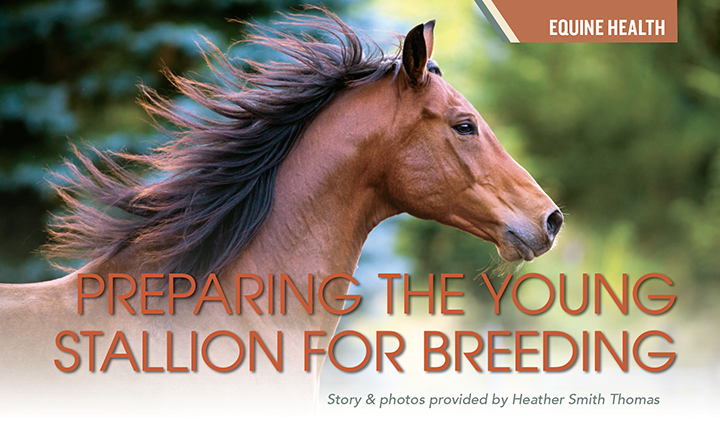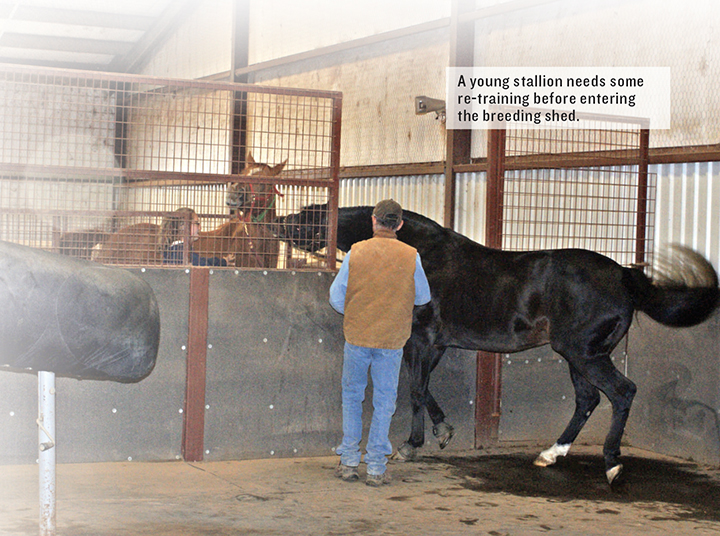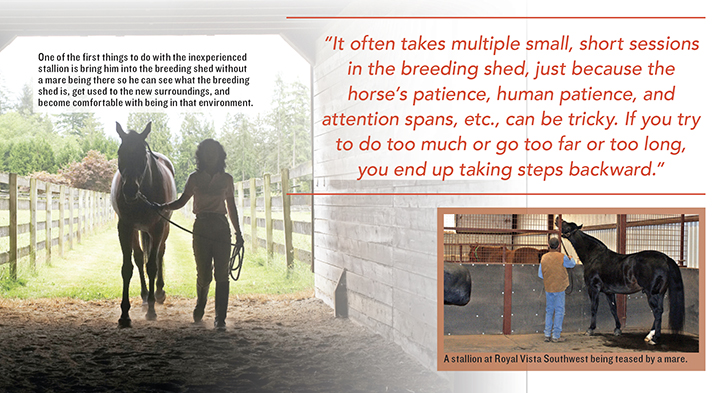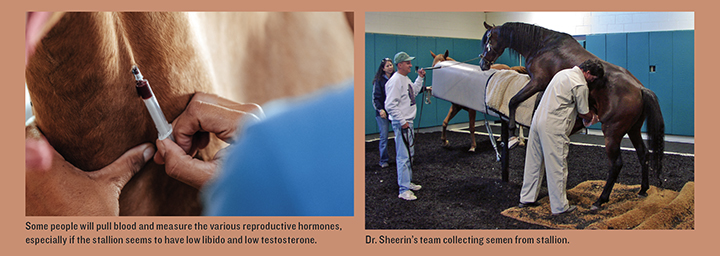
Preparing the Young Stallion for Breeding

Most young stallions that begin a breeding career have already proven themselves in a racing career. If the young horse has done well on the racetrack during his 2- and 3-year-old years, for instance, he may begin breeding mares as a 4-year-old. Before entering the breeding shed, he needs some re-training, a fertility evaluation, and some time to refocus on his new job and prepare for his first breeding season.
The main thing is getting the novice stallion prepared mentally and physically, and this means getting a little more weight on them. They were very fit for racing, and they need to have more fat. It takes energy for breeding; they will be burning a lot of calories. They usually need to gain some extra weight, and need to be monitored during the breeding season to see if they need more feed or turnout time.
They also need to find out that it’s okay to act like a stallion. When these young horses first come off the track, they’ve been told all their life not to rear up or try to mount mares. They were required to have good manners for their racing career. When they are first presented with a mare, they may be confused and wonder what they are supposed to do, and may be reluctant at first. Some of them switch gears quickly, and the first trip to the breeding shed they’ll breed a mare, but it generally takes a little time. It might be the first trip, or it might be the 6th trip before they feel comfortable. The urge to breed takes over and instinct kicks in, and they go ahead and mount the mare.

Dr. Peter Sheerin, Rood & Riddle Equine Hospital, Lexington, Kentucky, says the biggest thing is that most of these young stallions are coming off the track as fit athletes and need to be given time to let down before we start doing anything with them.
“If the owner is considering first-season infertility insurance, that needs to be done before anything else with that horse. The insurance exam must be done before semen is obtained from the horse, and is based on testicular size, a physical exam, etc. You don’t know what his semen is like, but obviously if he has decent-size testicles he should produce adequate semen. The insurance companies have enough information on a lot of stallions to know that if the horse passes this type of exam, he will likely do fine,” explains Sheerin. The horse will also be tested for EVA (equine viral arteritis) and CEM (contagious equine metritis) which are both transmitted by breeding.
After the horse has had a chance to transition from racing and has been “let down” with some turnout time, it’s time to start working with him and start introducing him to mares. “The key is to have a good team working with that stallion, and to have good mares. You don’t want to try his first breeding with maiden mares.” You need a dependable, mellow mare that will be patient with a young stallion.
“This all takes a lot of patience. This is the biggest challenge—with the horses that don’t pick it up quickly—when everyone is impatient and maybe wanting to use drugs to get him going. You may have to introduce the stallion to multiple mares. He may have been disciplined enough in his life that it takes him a long time to figure out that it’s okay to have an erection or be loud around a mare. It’s okay for him to just be a stallion,” says Sheerin.
The other key to success is a good stallion handler. “You walk a very fine line with discipline and safety and need to give that stallion as much leeway as you can while still keeping him under control, with manners and respect for the mare and his handlers. If some of these young horses get a little carried away or get too close and then get overtly corrected, you’ve taken a huge step backward,” says Sheerin.
Once he starts breeding mares and knows what the breeding shed is for, he needs to learn manners, but you need to teach him gently. You don’t want him to be bad, but you also don’t want to discourage breeding behavior. We want him to be eager to go down there and breed a mare, but not get out of control or try to savage the mare. He still needs some manners, and it’s a fine line. He can act like a stallion, but still has to be a gentleman when he comes to breed a mare. He needs to breed the mare, respect her, get off her, and go back to his barn with no problems.

“It often takes multiple small, short sessions in the breeding shed, just because the horse’s patience, human patience, and attention spans, etc., can be tricky. If you try to do too much or go too far or too long, you end up taking steps backward. Everything you do should be in short intervals and end on a positive note.” Each horse is different, so you play it by ear with each one of them.
“The first thing you’d probably do with the inexperienced stallion is just bring him into the breeding shed, without a mare being there. Then he can see what the breeding shed is, get used to the new surroundings, and become comfortable with being there. Then you’d introduce him the next time to an experienced mare that’s in good heat. This can be a challenge because a lot of the time we are working with a young stallion in the late fall or in the winter, when mares are not cycling,” says Sheerin.
“Some farms have older, retired mares, and may treat them with estrogen to get them into heat, or they may have an ovariectomized mare that can be treated with estrogen. If mares are not cycling, you can treat them with exogenous hormones to get them to show signs of heat. Having a mare in natural heat is preferred over a mare that’s brought into heat with estradiol, however, because the stallion can tell the difference.”
Teasing is important, and this also takes patient handling. “In a natural environment with a stallion and a mare turned loose together, they spend a lot of time teasing head-to-head. They are facing each other during teasing, whereas many people want to just take the stallion to the back of the mare and expect him to jump on her. That’s not the natural way for breeding horses; left together on their own, they have lots of interaction head-to-head. And then the mare is the one that decides she’s ready, and she’ll spin around and get into position to be bred,” explains Sheerin.
“We have to mimic this to the best of our ability in the breeding shed in a controlled environment. Some facilities have a teasing bar or teasing wall so the stallion can tease the mare over the wall, and you don’t have to worry about him getting tangled up. As he progresses in confidence and becomes more comfortable with the situation, then you can take them out in the open to see how he breeds the mare.”
In some situations, the mare may be sedated, or have a front leg held up, or a twitch on her. “A lot depends on the mare and the stallion, to make sure he doesn’t get scared by an uncooperative mare,” says Sheerin.
“Then it’s just a matter of patiently letting him figure out what he needs to do. Many times, the young stallion will get an erection and then not know what the next step is. He may just stand behind the mare with an erection. Sometimes what we’ll do in that situation is just back the stallion up a little bit and then walk him forward until he bumps his chest against the mare’s back end. This is often enough to motivate him to jump.”
Then the next step is for the stallion to work on his aim. Inexperienced stallions don’t always have this figured out until they gain more practice. “They may try to go sideways on the mare or may be a little cockeyed. It’s a slow, patient process. If you rush up to some of these horses and help them, it may turn them off. You need a good crew that can work with the horse slowly and patiently and give him the time he needs. The goal is multiple good experiences, and then the majority of young stallions figure it out,” Sheerin says.
“One of the problems I often hear about is that the stallion doesn’t show much interest in the mare. You may need to try different mares, or house him near some mares so that he gets some sexual stimulation.” He’s led a very cloistered life up until this point, and it may take him a little time to adjust to this new role.
“In most cases, it just takes time. The time of year when you are starting with that horse will determine how much pressure there is on you to have him ready. If you are starting in the fall, you have plenty of time to keep at it, slowly but surely. But if you get that horse the middle of January and have to get him going by the middle of February, this will be more of a challenge,” says Sheerin.
“Sometimes people will pull blood and measure the various reproductive hormones, especially if the stallion seems to have low libido and low testosterone. There may be a link there, but the levels may also be low because of the time of year (stallions are seasonal breeders, just like mares). Low levels could also be due to treatment with a variety of different drugs during their racing career. What you see in the fall will be different from what you’ll see in the spring, but can give you a baseline,” he says.
 Some people put their stallions under lights, as well as their mares. “It doesn’t seem to make a big difference, but it does essentially the same thing as with a mare. It may increase sperm numbers somewhat, and ejaculates will become a little bit more dilute. In the fall we tend to see a more concentrated ejaculate than we do in the spring, but total sperm numbers won’t have a lot of variation,” says Sheerin.
Some people put their stallions under lights, as well as their mares. “It doesn’t seem to make a big difference, but it does essentially the same thing as with a mare. It may increase sperm numbers somewhat, and ejaculates will become a little bit more dilute. In the fall we tend to see a more concentrated ejaculate than we do in the spring, but total sperm numbers won’t have a lot of variation,” says Sheerin.
“Once the stallion is breeding in the spring, I like to get him trained and comfortable breeding a mare before I collect semen from him. This gives a good idea regarding what the stallion is actually producing and removes the need to collect him multiple times to figure his daily sperm output,” he says.
“In some cases when you get the stallion up on the mare and put the AV (artificial vagina) on him, this is a completely strange thing and it turns him off for the whole process. If I have a preference, I would rather have him breed a mare a few times first and be comfortable with that before we try to collect him,” Sheerin explains. “Then we perform the normal breeding soundness exam with two ejaculates an hour apart, measure testicles, etc.”
During his first breeding experiences, it’s also important to pay close attention to how well the stallion can handle things. This is something he’s never done before, and he uses some muscles he’s never used before. His back muscles may get sore. It pays to watch these young stallions and make sure they are breeding okay. Sometimes a horse that isn’t breeding very well just needs a little break--and maybe just breed one mare every two days until he feels 100% again. The first two years of a young stallion’s breeding career are learning experiences for the horse and for the handlers.
